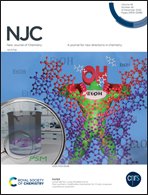Slow magnetic relaxation and selective luminescence sensor of Ln-radical chain involving imidazole-substituted nitronyl nitroxide radical†
Abstract
An imidazole-substituted nitronyl nitroxide radical NIT-Ph-3-(1-Im) was coordinated with Ln(hfac)3·2H2O to obtain five new one-dimensional lanthanide-nitronyl nitroxide radical complexes [Ln(hfac)3(NIT-Ph-3-(1-Im))]n (Ln = Gd 1, Tb 2, Dy 3, Ho 4, Yb 5; hfac = hexafluoroacetylacetonate; NIT-Ph-3-(1-Im) = 2-(3-(1-imidazole))-phenyl-4,4,5,5-tetramethyl-imidazoline-1-oxyl-3-oxide). The functionalized radical ligand NIT-Ph-3-(1-Im) acts as a bridge ligand to link two Ln(III) ions through a “head-to-tail” mode, leading to a one-dimensional chain. Variable temperature magnetization shows that the antiferromagnetic interactions dominate in complex 1. Magnetic studies reveal that slow magnetization relaxations occur in complexes 2 and 3. Furthermore, complex 2 exhibits an excellent application as a luminescence sensor for detecting Fe3+ cations and Cr2O72− anions with high sensitivity and selectivity according to luminescence quenching effects.



 Please wait while we load your content...
Please wait while we load your content...